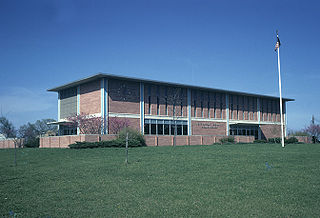
Jefferson County is a county located in the U.S. state of Kansas. Its county seat and most populous city is Oskaloosa. As of the 2020 census, the county population was 18,368. The county was named after Thomas Jefferson, the 3rd president of the United States.

Mahaska County is a county located in the U.S. state of Iowa. As of the 2020 census, the population was 22,190. The county seat is Oskaloosa.

Oskaloosa is a city in, and the county seat of, Mahaska County, Iowa, United States. In the late nineteenth and early twentieth century, Oskaloosa was a national center of bituminous coal mining. The population was 11,558 in the 2020 U.S. Census, an increase from 10,938 in 2000.
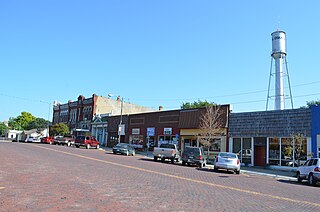
Oskaloosa is a city in and the county seat of Jefferson County, Kansas, United States. As of the 2020 census, the population of the city was 1110.
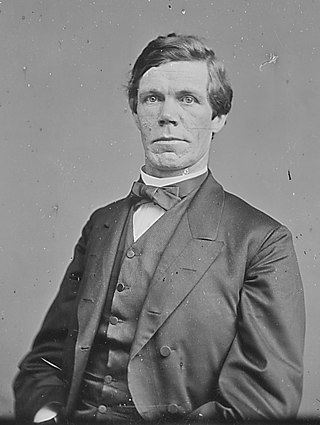
William Loughridge was a pioneer attorney, judge, and three-term United States Congressman from Iowa.

John Fletcher Lacey was an eight-term Republican United States congressman from Iowa's 6th congressional district. He was also the author of the Lacey Act of 1900, which made it a crime to ship illegal game across state lines, and the Lacey Act of 1907, which further regulated the handling of tribal funds. As the first federal conservation law, the Lacey Act of 1900 remains one of the foundations of conservation law enforcement.
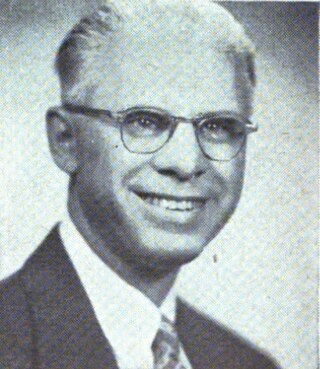
Donald Hayworth was a politician from the U.S. state of Michigan.

Marsena Edgar Cutts was a nineteenth-century politician and lawyer from Iowa. A Republican, he was most notable for his service as Attorney General of Iowa from 1872 to 1877 and in the United States House of Representatives from March 1881 to March 1883 and again from March 1883 until his death.
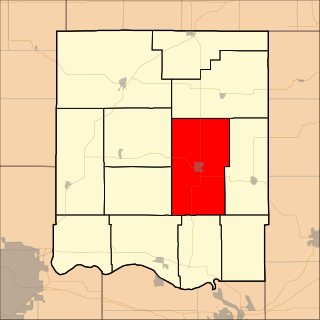
Oskaloosa Township is a township in Jefferson County, Kansas, USA. As of the 2000 census, its population was 2,142.

The Jack Lamberson House, also known as the Maunu house, is a historic residence located in Oskaloosa, Iowa, United States. It is one of seven Frank Lloyd Wright-designed Usonian houses located in Iowa, and one of two that were constructed in Oskaloosa. Both were completed in 1951. The Lamberson house is unique from the other Iowa Usonians for its extensive use of 60º and 120º angles. It features a low, sweeping pitched roof that makes the house look deceptively large, yet it is the second smallest of Iowa's Usonians. It was listed on the National Register of Historic Places in 1988.

The Mahaska County Courthouse located in Oskaloosa, Iowa, United States, was built in 1886. It was individually listed on the National Register of Historic Places in 1981 as a part of the County Courthouses in Iowa Thematic Resource. In 1986 it was included as a contributing property in the Oskaloosa City Square Commercial Historic District. The courthouse is the second building the county has used for court functions and county administration.

The Oskaloosa City Hall is a historic government building located in Oskaloosa, Iowa, United States. It was designed by Des Moines architect Frank E. Wetherell, an Oskaloosa native, in the Renaissance Revival style. It was originally designed along with the adjoining fire station in 1905. The buildings were designed for phased construction, and the city council decided to build the fire station first. It was individually listed on the National Register of Historic Places in 1991. Previously it had been included as a contributing property in the Oskaloosa City Square Commercial Historic District.

The Oskaloosa City Park and Band Stand is a nationally recognized historic district located in Oskaloosa, Iowa, United States. It was listed on the National Register of Historic Places in 1983. The listing includes one contributing site and five contributing objects. The town square, which is the site, was part of the original town plat in 1844. Landscaping projects were undertaken in the 1860s, 1911 and 1970–1971. In addition to the landscaping the sidewalks and curbing were installed in 1911. The bandstand in the center was designed by Des Moines architect Frank E. Wetherell, an Oskaloosa native, and built in 1912. The 29-foot (8.8 m) high octagonal structure is composed of concrete, iron and steel.

The Oskaloosa Fire Station is a historic building located in Oskaloosa, Iowa, United States. It was designed by Des Moines architect Frank E. Wetherell, an Oskaloosa native, in the Renaissance Revival style. It was originally designed along with the adjoining city hall in 1905. The buildings were designed for phased construction, and the city council decided to build the fire station first. Completed in 1908, it is a three-story brick building with a 4½-story bell tower. The fire station was individually listed on the National Register of Historic Places in 1991. Previously it had been included as a contributing property in the Oskaloosa City Square Commercial Historic District.

The Seeberger–Loring–Kilburn House is a historic residence located in Oskaloosa, Iowa, United States. The house was the work of David L. Evans, a master builder who completed it in 1859. It is the oldest known surviving work of his, and calls attention to his skill as a builder. Evans was a native of Wales and emigrated to the United States at the age of 14. He settled in Ohio and St. Louis before settling in Oskaloosa in 1845. The two-story, brick, Italianate structure features a hip roof and deck, bracketed cornice and simple hood molds. The second story was added in 1869 by Evans. Des Moines architect Frank E. Wetherell, who was born in Oskaloosa, designed an expansion of the house in 1916. It added the solarium on the east side, and a pergola on the west. The house was individually listed on the National Register of Historic Places in 1983. It was included as a contributing property in the Paradise Block Historic District in 1991.
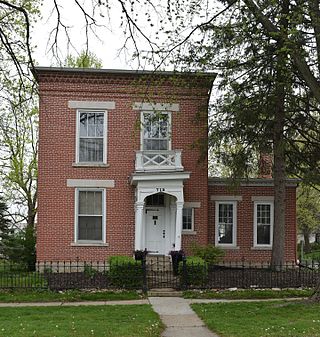
The Smith–Johnson House, also known as The Old Brick, is a historic residence located in Oskaloosa, Iowa, United States. It was built for William T. Smith in 1853, the same year he was elected as the first mayor of Oskaloosa. A lawyer, Smith was a native of Pennsylvania who settled in the town in 1848 and became county attorney the same year. In addition to his political and legal responsibilities he founded the first bank in town, and he was involved with other profitable financial ventures. He lived in the house until 1865 when Abijah Johnson, a Quaker merchant who moved to Oskaloosa to be a part of the flourishing Quaker communities here and in the surrounding areas. His son J. Kelly Johnson, an attorney who served in the Iowa Senate, took over the house after his father's death in 1894.
The Spring Creek Friends Cemetery is a historic site located northeast of Oskaloosa, Iowa, United States. The approximately one-half acre plot of land contains an unknown number of burials with about 123 having plain markers that date from the 1860s through the 1890s. There is a network of pedestrian paths in the cemetery, and it is surrounded by a fence with concrete posts on the south, west, and north sides. The cemetery was founded about 1848 and continued to accept burials until about 1892. It calls attention to the earliest period of Quaker settlement in Iowa, which at that time was primarily a rural phenomenon. The Spring Creek Meeting was established here in the 1840s or the 1850s, and was the site of the first Iowa Yearly Meeting in 1863. The Spring Creek Meeting merged with the Center Grove Meeting in 1894 and formed the Oskaloosa Monthly Meeting. The meetinghouse subsequently moved into Oskaloosa, and burials here dropped off. The cemetery was listed on the National Register of Historic Places in 1996.

Ulysses Simpson Grant Elementary School is a historic building located in Oskaloosa, Iowa, United States. Built in 1914, it replaced a school of the same name that had been built in 1876. The Neoclassical building was designed by Des Moines architect John W. Trafzer, and built by Buckler and Robertson. It was the first new school built in Oskaloosa in the 20th century, and part of an effort to rebuild or recondition the schools in the city. The addition of a multipurpose facility in 1957 followed the Mother's Crusade of 1956 to rebuild and modernize Oskaloosa schools system after World War II. It was designed by George Russell. Two other additions were built in 1978 and 1980. The building served the school system until 2004, after which the original portion of the building was converted into senior apartments and the newer additions into a senior center. The grounds have become a community park. The building was listed on the National Register of Historic Places in 2008.

The Oskaloosa Monthly Meeting of Friends Parsonage is a historic building located in Oskaloosa, Iowa, United States. Its historic significance is found in its association with nearby William Penn University in the context of the Quaker testimony in Oskaloosa. The country's entry into World War I created problems for the Quaker's Peace Testimony. The Oskaloosa Monthly Meeting counseled students from the college about military conscription and pacifism. Because of this the parsonage was vandalized in 1917 with yellow crosses painted on the house. The congregation's pastor, Clarence Pickett, was tied to a spring wagon and led through town. Some vandalism also occurred during World War II, including yellow paint smeared on the parsonage.
The former Oskaloosa Post Office is a historic building located in Oskaloosa, Iowa, United States. Completed in 1902, the Italian Renaissance Revival structure is composed of brick with decorative details in limestone and terra cotta. Plans in 2013 to convert the building into housing fell through. In 2019, a restoration project was begun to shore up the building. It was listed on the National Register of Historic Places in 2020.


















